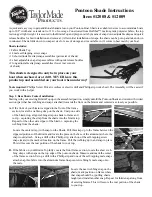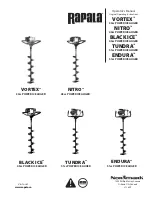
Teardrop Campers • nucamprv.com
30
nucamprv.com • Teardrop Campers
31
4. Make sure you have a shore power connection or a full propane tank
and charged 12V battery. The Alde
®
will run off 120V shore-power
alone, or off propane and 12V.
5. If you have checked all the above, you are ready for operation.
Power on the Alde
®
monitor mounted in the nuCamp control panel,
select a power source, adjust to your desired temperature and enjoy
the warmth and comfort of the Alde
®
Heating System.
Most of this information was obtained from the Alde
®
3020 Compact
Manual. For complete details on operating the Alde
®
Heating System,
please see the included operator’s manual in your owner’s packet.
ALDE FLOW
Basic information about the Alde Flow function:
1. The Alde
®
Flow is designed as an assistance to the Alde
®
3020
Compact boiler. About the size of a shoe box, you will find it
installed beside the boiler if your camper is equipped with it.
2. The Flow is not a hot water reserve tank but rather serves as a heat
exchanger assistance to the boiler.
3. There are no electric heating elements or combustion chambers
inside the Flow.
4. The boiler pumps hot glycol into the Flow where it warms the cold
water coming from the fresh water tank by convection, taking the
chill off the cold water. The warmed water is then pumped into the
boiler and further heated.
5. The Flow lightens the load on the boiler and increases the amount
of hot water available for showers. The boiler can provide more hot
water with the extra assistance.
6. With the Alde
®
flow equipped there is an extra safety relief valve
that needs to be drained when winterizing the plumbing system.
7. Controls for the Alde
®
Flow are all built into the Alde
®
System.
Operate the Alde
®
system as normal. The Flow does not have
separate controls.
Consult the Alde
®
Flow operator manual for detailed instructions on
operation. A copy is included in the Owner’s Packet.
AIR CONDITIONING
Important information about operating air conditioners in your camper:
• Starting an air conditioner early in the day will not only lower
temperatures, it will remove excess humidity and help the camper
stay cool when the day gets hot.
• The air conditioner assists in ventilating the camper and promoting
a healthy air flow by recycling stale air and bringing in fresh air.
• The air conditioner is the largest single load on the electrical system.
• The air conditioner only operates on shore power. When camping
without shore power you will need to use an appropriately sized
generator to run the air conditioner. Use 30 Amp Shore Power only.
Running the system on a 15amp circuit can overload the circuit.
• DO NOT use the microwave and air conditioner at the same time. It
will likely trip breakers.
• Generally, RV air conditioners are only designed to cool the inside
air approximately 20° F lower than the outside air. This is not a
defect. In temperatures of 100°F or higher, such as in the southwest
United States, this should be taken into consideration.
• Keep windows and other vents closed when operating the
air conditioner.
• Hot air rises and cool air drops. The air conditioner gathers air
via the intake slots cut into the dinette cabinetry, cools it (creating
condensation and discharging water through its vents) and then
ejects the air higher up where it circulates downward due to being
cooler or in other areas away from the intake.
• Never close or obstruct the air intake. This will cause the air
conditioner to malfunction and slow down cooling.
When camping in hot weather, especially during the day, the camper will
absorb heat from the sun and the surrounding atmosphere. This is known
as heat gain. If you can reduce this, especially in extreme hot weather, you
have won half the cooling battle.
To reduce heat gain and increase air conditioner cooling in high
temperature weather:
• Seek shaded areas to park your camper, such as beneath trees.
• Close all windows, shades and curtains. For an extra heat shield,
insert an automotive windshield sun shade, cut to size, into each
of the windows. Some shades may have a reflective coating on the
exterior side already.
• Keep heat emitting appliances such as the Alde
®
System, stove top
and microwave turned off.
• Extend any equipped awnings. This will shade the sides of the
camper from sun exposure.
• Start the air conditioner early in the morning to give it a head start
on the day.
• Turn the air conditioner on its highest setting.
Refer to the air conditioner’s operator manual for detailed operating
instructions. This is included in your owner’s packet.
FAN VENTILATION
The fan vent(s) installed in the roof creates fresh air circulation and removes
stale air from the camper. It is powered by 12V or shore power and may be
equipped with either manual or remote controls.
• Always ventilate the camper while sleeping.
• The fan will not ventilate well if an air inflow source such as a
window is not opened. For best ventilating results, open a window
the farthest distance from the fan so air can flow through the
entire camper.
• See operating instructions of the fan vent included in the
owner’s packet.
















































